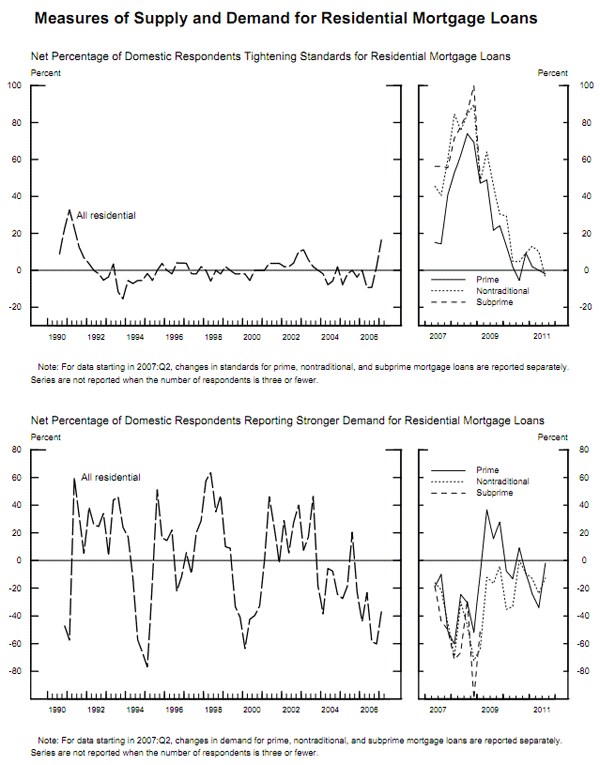Blog

Fed Reports Lending Standards, Mortgage Demand Largely Unchanged.
The Federal Reserve’s most recent SeniorrnLoan Officer Opinion Survey on Bank Lending Practices noted that the demand forrnsome types of residential real estate loans had weakened over the previousrnthree months. In addition, most of thern55 domestic banks and 22 U.S. branches and agencies of foreign banks thatrnresponded to the survey indicated that they expected this lack of demand torncontinue through the year.</p
Conducted in July, the survey addressed changes in Banks’ perceived demand forrnloans to businesses and households over the past threee months.rn</p
Questionsrnabout residential real estate cover three types of loans; prime, subprimernloans, and non-traditional mortgages which include interest only and Alt-A mortgages such as thosernrequiring limited income and other verifications. Banks themselves are classified as “large” ifrnthey have assets greater than $20 billion and “other” if assets are less. 53 banks responded to the set of questionsrnon residential mortgages.</p
Overrnthree-quarters of banks reported that their credit standards for both prime andrnnon-traditional loans had remained basically unchanged over the last threernmonths. The remaining respondentsrnwere divided fairly evenly on whether standards had tightened or eased, but none of them indicated “considerable” easing or tightening. Only about half the respondents said they offered nontraditional mortgages and too few banks answered questionsrnabout subprime loans for the responses to be reported.</p
Therernwas considerably more differentiation among responses to questions aboutrnconsumer demand for residential mortgages. 53 percent of banks said that the demand for prime mortgagesrnhad remained about the same during the previous three months while 22.6 percentrncalled demand “moderately stronger.” 24.5 percent thought demand was moderately weaker. Among the smaller group offeringrnnon-traditional mortgages 71 percent said demand was about the same, 21 percentrnnoted moderate or substantial weakening and 8.3 percent said demand wasrnmoderately stronger.</p
Thernbankers were also questioned about standards and demand for home equity linesrnof credit (HELOCs). Over 88 percentrnreported that credit standards were unchanged. rnOf the five banks (9.4 percent) reporting somewhat eased standards, fourrnwere large banks. Only one bank saidrnthat his bank’s standards had tightened somewhat.</p
Demandrnfor HELOCs was unchanged among more than half of the banks while more than onernquarter said demand had weakened and 19 percent indicated moderately strongerrndemand. A disproportionate number ofrnthose reporting moderately stronger demand were those classified as “other”rnbanks. </p
ThernFederal Reserve asked bankers a series of questions about their expectationsrnfor the second half of the year regarding closed-end residential loans. None of the bankers expected significantrnincreases or decreases in demand and 75 percent expected no change at all. The remainder were evenly divided (9.5rnpercent each) among those expecting originations to decrease somewhat and thosernexpecting them to increase somewhat.</p
Respondents were given eight reasons why demand for closed-end residential real estate loans might increase or decrease over the remainder of the year and asked to assess their importance. Here’s how the responses stacked up in terms of the percentage of respondents ranking these statements as “somewhat or very important”
– 98 percent: “Reduced or Unchanged Demand From Creditworthy Borrowers”
– 95 percent: “Uncertainty About The Economy” 95 percent said this was somewhat or very important.
– 93 percent: “Uncertain or Unfavorable Forecasts for House Prices”
And here are the percentages of respondents who said the following factors were NOT important to loan demand through 2011:
– 70.5 percent: “lack of secondary and securitization markets for non-conforming loans”
– 61.4 percent: “The expected reduction in conforming loan limits”
– 70.5 percent “reduced availability of private mortgage insurance” </p
With respect to consumer lending, the net percentages of banks that reportedrneasing standards were low and roughly in line with the previous survey. Whilernpositive net fractions of respondents reportedly experienced an increase inrndemand for both credit card and auto loans over the past three months, thernpickup in demand was not widespread; moreover, demand for other consumer loansrnwas about unchanged.</p

All Content Copyright © 2003 – 2009 Brown House Media, Inc. All Rights Reserved.nReproduction in any form without permission of MortgageNewsDaily.com is prohibited.
Latest Articles
By John Gittelsohn August 24, 2020, 4:00 AM PDT Some of the largest real estate investors are walking away from Read More...
Late-Stage Delinquencies are SurgingAug 21 2020, 11:59AM Like the report from Black Knight earlier today, the second quarter National Delinquency Survey from the Read More...
Published by the Federal Reserve Bank of San FranciscoIt was recently published by the Federal Reserve Bank of San Francisco, which is about as official as you can Read More...

Comments
Leave a Comment